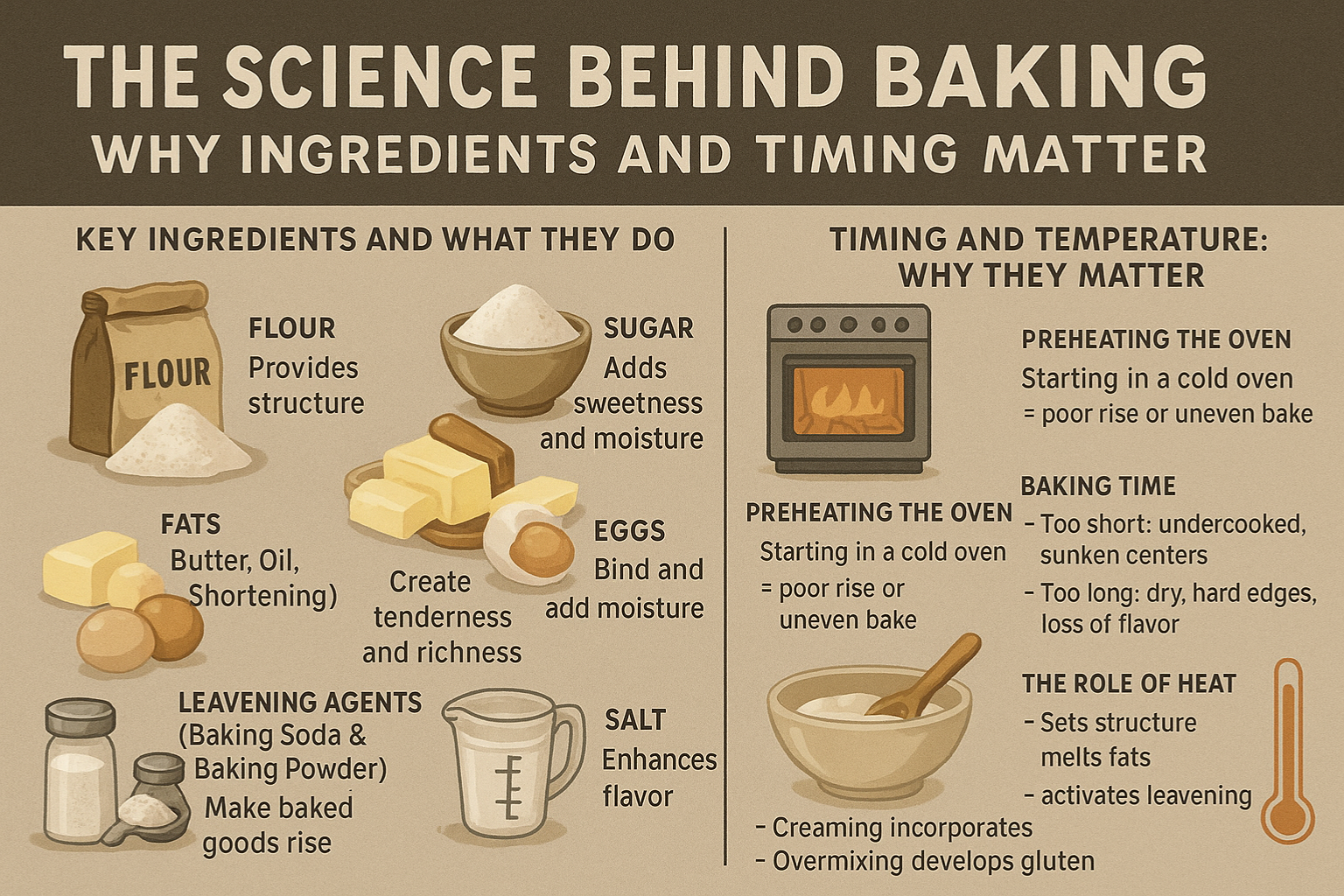Ever wondered why your cake didn’t rise, why your cookies spread too much, or why your brownies turned out dry? The answer often lies in the science of baking.
Baking isn’t just mixing ingredients — it’s a delicate chemical process. Once you understand how your ingredients interact and why timing and temperature matter, your desserts will go from “okay” to outstanding.
Let’s explore the science behind baking and how small changes can make a big difference.
Why Baking Is More Science Than Cooking
Cooking often allows improvisation — a little more of this, a pinch of that. But in baking, precise measurements, order, and temperature determine the outcome.
Each ingredient has a specific role and works in balance with others. Mess up one element? Your entire dessert can change.
🧪 In baking, you’re not just making food — you’re triggering chemical reactions.
Key Ingredients and What They Do
1. Flour
Flour provides structure through proteins (mainly gluten).
- All-purpose flour is most common
- Cake flour has less protein — lighter texture
- Overmixing flour = more gluten = dense, chewy results
Think of flour as the dessert’s foundation.
2. Sugar
Sugar does more than sweeten. It:
- Adds moisture (pulls water into the mix)
- Helps with browning through caramelization
- Affects texture (softness, chewiness)
Less sugar = less moisture and color.
3. Fats (Butter, Oil, Shortening)
Fats add tenderness, richness, and flavor.
- Butter: Adds flavor and structure
- Oil: Makes cakes moister
- Shortening: Helps hold shape (ideal for cookies)
Fats coat flour, limiting gluten and softening texture.
4. Eggs
Eggs bind ingredients and add moisture, fat, and structure.
- Yolks: Richness and emulsifying
- Whites: Protein and stability (great for meringue)
- Beating eggs introduces air, important for leavening
Too many eggs = rubbery texture
Too few = dry, crumbly dessert
5. Leavening Agents (Baking Soda & Baking Powder)
They make your baked goods rise by creating gas bubbles.
- Baking soda: Needs acid (like lemon or yogurt) to activate
- Baking powder: Contains both acid and base — works with moisture + heat
Wrong amount = flat or overly risen/domed desserts.
6. Liquids (Milk, Water, Juice)
Liquids hydrate dry ingredients and help form gluten and steam.
- Milk adds richness and helps with browning
- Water creates a crisper texture
- Juices alter pH and flavor
Too much liquid = gummy texture
Too little = dry and crumbly
7. Salt
Salt enhances flavor and balances sweetness.
- Just a pinch boosts chocolate, fruit, and caramel flavors
- Also strengthens dough by tightening gluten
Salt in desserts? Absolutely necessary.
Timing and Temperature: Why They Matter
Preheating the Oven
Starting in a cold oven = poor rise or uneven bake.
Always preheat for at least 10–15 minutes.
Baking Time
- Too short: Undercooked, sunken centers
- Too long: Dry, hard edges, loss of flavor
Use a timer, but also trust your eyes and nose.
Mixing Methods: Not Just Stirring
Creaming (Butter + Sugar)
- Incorporates air for a light texture
- Common in cakes and cookies
Folding
- Gently combines ingredients like whipped cream or egg whites
- Keeps air bubbles intact
Overmixing
- Develops gluten
- Makes cakes tough or cookies flat
The Role of Heat in Baking
- Heat sets structure (eggs coagulate, starches gelatinize)
- Melts fats for texture
- Evaporates moisture for crispness
- Activates leavening agents
Too high a temperature? Burnt edges, raw center.
Too low? Pale color, no rise.
Why Ingredients Should Be at Room Temperature
- Room-temp eggs, butter, and milk combine more easily
- Helps trap air for better rise
- Prevents batters from curdling
Take ingredients out 30–60 minutes before baking.
The Science of Cooling
Letting desserts cool:
- Helps them set properly
- Prevents soggy bottoms (especially pies or bars)
- Keeps glazes and frostings from melting
Cooling on a rack allows air to circulate evenly.
Final Thought: Bake Smarter, Not Harder
When you understand how ingredients work together and why timing matters, you bake with confidence — and consistently better results.
Baking isn’t magic. It’s delicious science in action.
So next time your cookies spread too much or your cake sinks, don’t give up. You might just need a little science tweak — and now you know exactly where to start.

